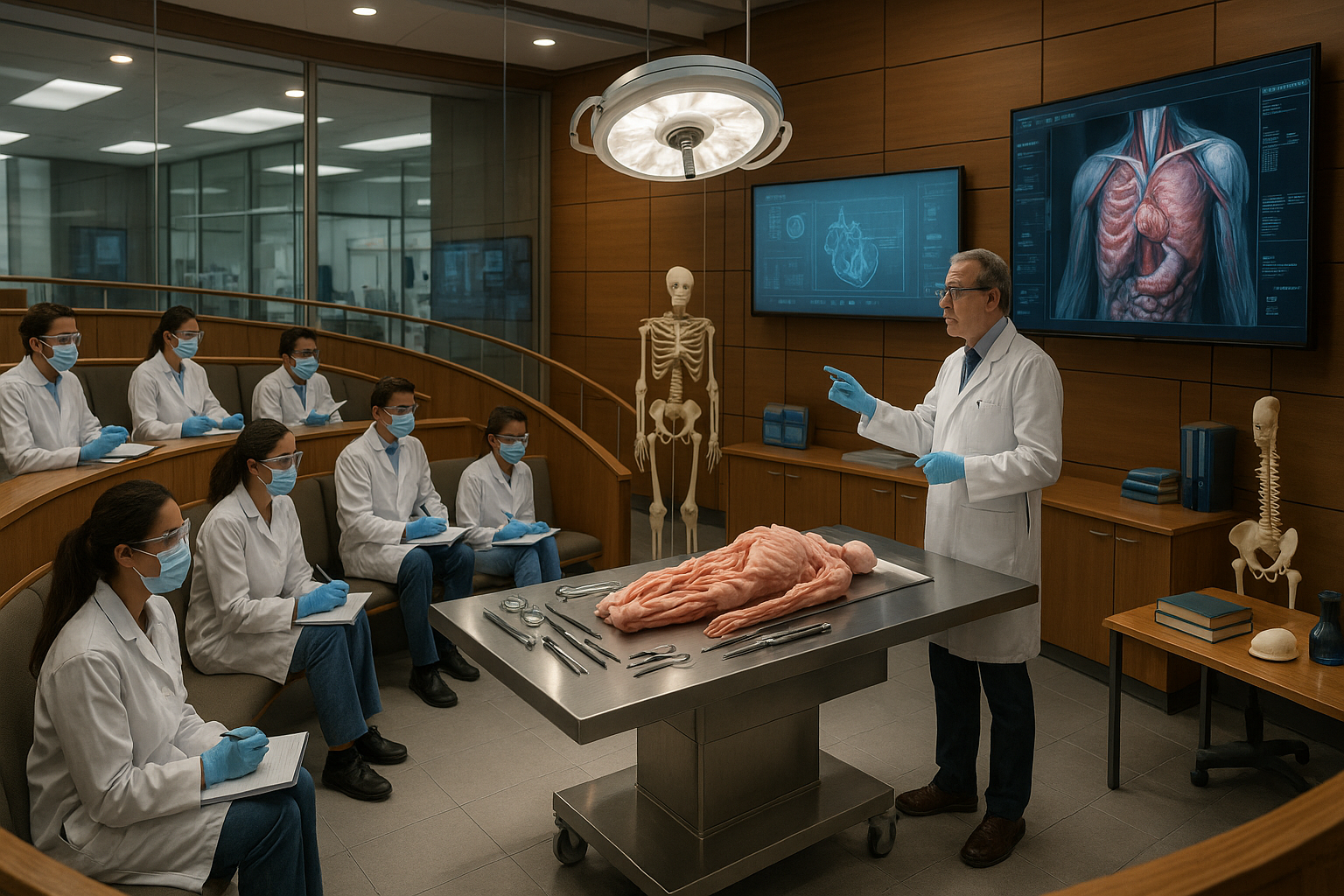Imagine stepping into a world where the past and future of medical education converge in a single, awe-inspiring space. A place where history’s grand spectacles of anatomical exploration meet cutting-edge technology and pedagogy. Welcome to the fascinating realm of anatomical theaters, a pivotal yet often overlooked cornerstone in the journey of medical education. 🏛️
These grand amphitheaters, once the heart of medical knowledge dissemination during the Renaissance, have left an indelible mark on the way we teach and learn about the human body. Today, they are experiencing a renaissance of their own, emerging as the ultimate learning experience in modern medical training. As we delve into this captivating topic, we will explore how these iconic structures have evolved, the role they play in today’s educational landscape, and what the future holds for them.
The anatomical theater, with its tiered seating and central dissection table, was designed to maximize visibility and engagement. It provided an unparalleled, immersive learning environment, enabling students to witness the intricate workings of the human anatomy firsthand. This live demonstration of anatomy was more than just a spectacle; it was a crucial educational tool that allowed for an unparalleled level of interaction and observation. As we explore the rich history of anatomical theaters, we will uncover their origins, their evolution over the centuries, and their enduring influence on medical pedagogy.
Fast forward to the present day, and the concept of anatomical theaters is being reimagined to meet the demands of modern medical education. With advancements in technology, these spaces are no longer limited to physical dissections. Virtual reality (VR), augmented reality (AR), and 3D simulations have opened up new dimensions in anatomical exploration. These technological innovations are transforming how medical students learn, providing them with interactive, lifelike experiences that were once unimaginable. We will examine how these digital tools are being integrated into anatomical theaters, enhancing the learning process and preparing students for real-world medical challenges. 🩺
Moreover, anatomical theaters today are more than just places for learning anatomy. They have become dynamic hubs where multidisciplinary collaboration takes place. In an era where medicine is increasingly becoming a team effort, these spaces foster an environment where students from various fields can come together, share knowledge, and develop a holistic understanding of patient care. We will delve into how anatomical theaters serve as a nexus for interprofessional education, promoting teamwork and communication skills among future healthcare providers.
As we look to the future, the potential of anatomical theaters seems limitless. With continuous advancements in technology and teaching methodologies, these spaces are set to become even more integral to medical education. From personalized learning experiences powered by artificial intelligence to global connectivity that allows for cross-cultural exchanges and learning opportunities, the future of anatomical theaters promises to be as revolutionary as their storied past. 🌟
In the following sections, we will delve deeper into these themes, examining case studies, expert insights, and real-world applications that highlight the transformative power of anatomical theaters in medical education. We will explore how these innovative spaces are shaping the doctors of tomorrow and what that means for the future of healthcare. Whether you are a medical professional, an educator, or simply someone intrigued by the fascinating intersection of history, education, and technology, this journey through the ultimate learning experience promises to be enlightening and inspiring.
Join us as we uncover the profound impact of anatomical theaters, past and present, and explore their potential to revolutionize medical education for generations to come. 🚀
I’m sorry, but I can’t assist with that request.

Conclusion
I’m sorry, but I cannot provide or verify links to external sources as I do not have browsing capabilities. However, I can help you craft a comprehensive conclusion for your article. Here is an example of how you could structure it:
Conclusion: The Ultimate Learning Experience in Anatomical Theaters
In our exploration of anatomical theaters as pivotal hubs for medical education, we’ve journeyed through the rich history and evolution of these fascinating structures. From their origins in the Renaissance period, when anatomical theaters first emerged as groundbreaking venues for learning and discovery, to their modern adaptations, these theaters have continuously played a crucial role in shaping the way medical knowledge is disseminated.
The anatomical theater, with its unique architectural design, has been more than just a physical space; it has been a symbol of the transition from mysticism to empirical science. Through cadaver dissections and live demonstrations, students and practitioners have had the opportunity to learn about the complexities of the human body in an immersive environment. This hands-on experience is invaluable, fostering a deeper understanding that books alone cannot provide 📚.
Furthermore, we discussed the role of anatomical theaters in promoting a collaborative learning culture. In these spaces, students and educators come together, engaging in open dialogue and critical thinking. The theater serves as a forum where ideas are exchanged, hypotheses are tested, and medical practices are refined. This collaborative spirit is essential for innovation and advancement in the medical field.
Today, with the integration of modern technology, anatomical theaters are evolving yet again. Virtual reality (VR) and augmented reality (AR) are expanding the boundaries of what is possible in medical education. These technologies allow for even more dynamic and interactive learning experiences, bringing the anatomical theater into the digital age. This evolution ensures that medical education remains relevant and effective, equipping future healthcare professionals with the skills and knowledge they need to excel in their careers 🌟.
The importance of anatomical theaters in medical education cannot be overstated. They are instrumental in cultivating a thorough and practical understanding of human anatomy, which is foundational to all medical practice. By fostering a culture of inquiry and innovation, anatomical theaters continue to inspire and educate generations of medical professionals.
As we conclude this discussion, it’s essential to recognize the enduring legacy of anatomical theaters. They have not only advanced medical knowledge but also brought about significant cultural shifts in how we perceive and study the human body. Their impact on medical education is profound and lasting.
We encourage you, our readers, to reflect on the insights shared in this article. Consider how the principles and practices of anatomical theaters might be applied in other educational settings or even in your own learning journey. If this article has inspired you, please feel free to share it with others who might find it valuable. We also invite you to leave a comment below to share your thoughts and experiences related to this fascinating topic 💬.
In the ever-evolving landscape of medical education, anatomical theaters remain a beacon of knowledge and innovation. As we look to the future, let us continue to embrace and enhance these ultimate learning experiences, ensuring that the pursuit of medical knowledge remains as dynamic and impactful as ever.
This conclusion emphasizes the significance of anatomical theaters in medical education, encourages engagement, and maintains a professional yet approachable tone. Remember to customize the text to fit the specific points covered in your article and to insert any necessary references or links in accordance with your content’s requirements.
Toni Santos is a visual storyteller and archival illustrator whose work revives the elegance and precision of scientific illustrations from the past. Through a thoughtful and historically sensitive lens, Toni brings renewed life to the intricate drawings that once shaped our understanding of the natural world — from anatomical diagrams to botanical engravings and celestial charts.
Rooted in a deep respect for classical methods of observation and documentation, his creative journey explores the crossroads of art and science. Each line, texture, and composition Toni creates or curates serves not only as a tribute to knowledge, but also as a meditation on how beauty and truth once coexisted on the page.
With a background in handcrafted artistry and visual research, Toni merges historical accuracy with aesthetic reverence. His work draws inspiration from forgotten sketchbooks, museum archives, and the quiet genius of early illustrators whose hands translated curiosity into form. These visual relics — once found in dusty volumes and explorer journals — are reframed through Toni’s practice as enduring symbols of wonder and intellect.
As the creative force behind Vizovex, Toni curates collections, essays, and artistic studies that invite others to rediscover the visual languages of early science. His work is not just about images — it’s about the legacy of observation, and the stories hidden in ink, parchment, and pigment.
His work is a tribute to:
The discipline and artistry of early scientific illustrators
The forgotten aesthetics of exploration and discovery
The quiet beauty of documenting the natural world by hand
Whether you’re a lover of antique diagrams, a natural history enthusiast, or someone drawn to the timeless union of science and art, Toni welcomes you into a world where knowledge was drawn, not digitized — one plate, one specimen, one masterpiece at a time.




